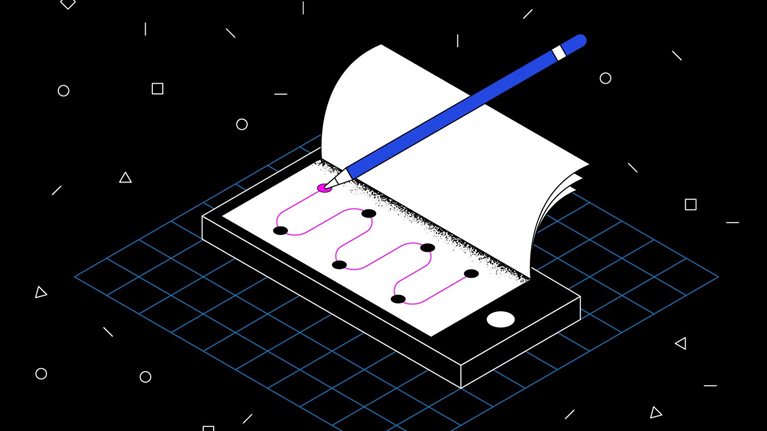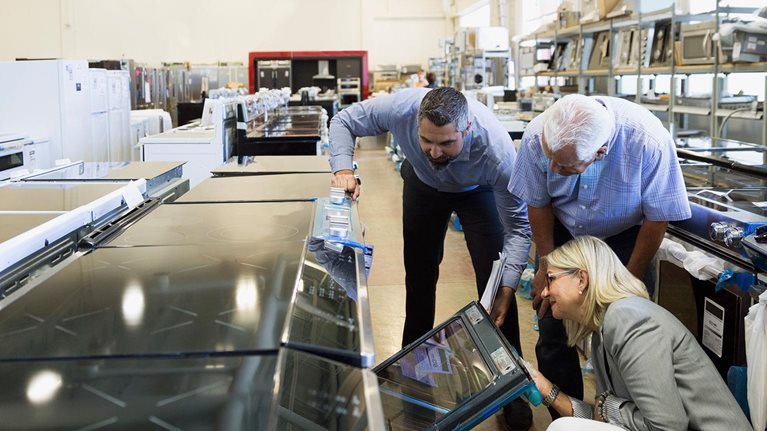The role of the store has changed. With customers increasingly shifting their spending online, it’s not enough for a brick-and-mortar store to be just a transactional venue. Instead, it now must serve as a brand-building environment in which customers can have special, in-person experiences that can’t be replicated in digital channels. To keep their stores relevant, retailers need to make the most of physical stores’ built-in sensory advantages over e-commerce—they need to tout the experience of touching, smelling, and trying on products, and they must ensure that the in-store experience is enjoyable and convenient. Otherwise, customers simply won’t bother making the trip.
In most cases, creating a distinctively compelling customer experience will require retailers to redesign their store formats. And there’s no time to lose; competitors are moving fast. Even companies that started as pure-play online retailers—such as Amazon, eyeglasses retailer Warby Parker, sneaker brand Allbirds, and luggage company Away—are opening brick-and-mortar stores so that they, too, can offer sensory experiences. So, for traditional retailers, the pressure is on; the time to invest in format redesign is now.
Yet many retailers still only refresh their store formats in three- to five-year cycles. That’s an eternity in today’s world, where consumer demands and behavior are changing rapidly. Furthermore, traditional format redesign is a costly, multiyear effort that involves overhauling several departments or even the entire store. It carries significant risk, because retailers have no guarantee that the redesign, once it’s complete, will generate the desired results. It could turn out to be a tremendous waste of time and money.
What should retailers do instead? For speedier and less expensive format redesign that quickly yields returns on investment, we recommend an approach that marries the creativity and empathy of design thinking with the discipline and speed of agile methodologies. Such an approach focuses on continually making one-off, high-impact changes rather than department-wide or storewide remodels. Indeed, retailers must adopt a mind-set of “never being done”: format redesign should be an ongoing process of implementing solutions quickly and refining them constantly, with retailers keeping their fingers on the consumer pulse and adapting store formats to respond to evolving consumer needs. In our experience, format redesign done in this way can boost sales by 10 to 15 percent and customer satisfaction by 20 percent, all within a year or less.
Design thinking and agile techniques: A powerful combination
Design thinking is a creative, empathetic, customer-centric approach to solving problems.1 In the context of format reinvention, design thinking minimizes the risks because it prioritizes customer needs and the customer experience along with the company’s financial goals. It seeks to understand the customer’s perspectives and build solutions around those rather than starting out with a strong hypothesis as to what the solutions should be.
To discern customers’ underlying needs, retailers should intently listen to consumers and closely observe them both inside and outside the store environment (more on that later in the article). In doing so, retailers can incorporate the customer perspective into every aspect of the format redesign. Customers can become co-creators of new features and functionality within the store.
Insights gained through design thinking should inform the specific in-store elements (the “what”) of a format redesign. Agile methodologies should then dictate the process (the “how”). Just like with design thinking, an agile process involves first proactively seeking customer input. The next steps are to generate actionable insights rapidly, test prototypes right away, and then repeat the cycle—thereby delivering results in a much shorter time frame than the traditional process does (Exhibit 1).

Among the signature elements of agile ways of working are small, co-located, cross-functional teams comprising business, technology, and design experts.2 Each team is in charge of one specific part of the redesign and takes full ownership of it—for instance, one agile team might be responsible for the in-store checkout process. Agile teams develop, evaluate, and prioritize ideas and initiatives, and they are empowered to make decisions and refine plans along the way. They engage in rapid test-and-learn cycles called “concept sprints,” which are well suited to implementing one-off redesign efforts that yield results quickly.
Cornerstones of format redesign
When governed by an agile design-thinking mentality, a format redesign consists of four core elements, or cornerstones: format strategy, customer-journey mapping, customer-centric ideation, and technology enablement. The middle two elements are critical to delivering a retail experience that truly meets consumers’ needs and expectations—yet, these elements are often given short shrift or overlooked in retailers’ approach to format redesign.
Defining the format strategy
In redesigning a store format, a retailer should define its strategy or “retail vision” for that format. What role should the format play within the retailer’s omnichannel strategy? Will it function as a flagship store? Will it be a showroom for new products, with little to no inventory? Will its value proposition be to attract customers because of price, convenience, service, or assortment (since a retailer can achieve true distinctiveness in only one or two of these)? How will it be positioned against competitors?
Would you like to learn more about our Retail Practice?
Other strategic decisions that the retailer needs to make include how to brand the format (for example, will the format carry the main brand, an existing subbrand, or an entirely new brand?), how to allocate space in the store to the various product categories, and which customer segments the format will target.
The format strategy should be heavily informed by consumer insights. A retailer should therefore launch a qualitative research workstream—incorporating the two elements we discuss next—in parallel with strategy development.
Mapping the customer journey
What are the customer’s needs and desires, and what prompts those desires? What are the reasons for the customer’s store visit? When customers are in the store, how do they navigate the aisles and interact with the displays? What barriers—physical or otherwise—do they encounter? What are their biggest pain points?
These are the kinds of questions a retailer should seek to answer when redesigning a store format. The best format-redesign ideas surface when a retailer truly understands the customer journey, which is the end-to-end experience that a customer has with the retail brand. A retailer must take into account each customer touchpoint and assess a customer’s emotional state at each stage of the journey.
Ideally, retailers would use a variety of methods—including structured interviews, ethnographic techniques, and analysis of internal data (such as customer complaints, customer-satisfaction surveys, and point-of-sale data)—to understand the customer journey. Design thinking seeks to uncover a consumer’s unspoken desires, motivations, and concerns, delving beyond easily articulated needs such as “I need to buy lunch.” Consider the purchase of a sandwich at a supermarket’s deli section. Perhaps the unarticulated need is for “a quick but satisfying meal that I can take with me to the park, so I can get away from my stressful office and relax outdoors during my lunch hour.” Only by generating this deeper level of insight can retailers move from focusing purely on products to focusing on experiences.
A customer-journey map is incomplete—perhaps even useless—if it doesn’t document the customer’s emotions at each stage of the journey. Emotions reveal what’s important to customers. Understanding those emotions will therefore help the retailer design experiences that the customer will not only appreciate and remember but also want to repeat. Exhibit 2 illustrates part of a journey map, showing the customer’s experience just before, during, and just after a store visit.
By studying customer-journey maps in aggregate, a retailer can begin to see patterns and themes, which can then inspire and guide the format redesign. Retailers should build the shopping experience around the moments that evoke the strongest emotions in customers.
Some of the most interesting areas for exploration and innovation are in the junctions of customers’ conflicting desires. Exhibit 2 indicates, for instance, that the customer likes to shop with her partner, but the two of them have different shopping styles and rhythms. Retailers should brainstorm novel ways to resolve such conflicts. In this case, perhaps the retailer could develop a mobile app that allows shoppers to check off items on their shared shopping lists in real time.
Translating customer insights into ideas and concepts
To improve customer experience at the most relevant points along the customer journey, retailers should gather user stories or testimonials that describe a specific part of the journey (for example, the checkout process). Testimonials help explain what the customer wants and expects from the shopping experience and what the specific points of frustration might be.
These testimonials, along with other observations and insights gleaned from customer-journey mapping, will dictate each agile team’s specific to-dos. In the traditional approach, one aspect of the format redesign might be, “install four new customer-service kiosks on the sales floor.” In an agile format redesign, on the other hand, the team would agree on a mission—such as “improve service quality and conversion rate in the store”—without specifying the solution. The team would instead synthesize the consumer insights and observations into concise “opportunity briefs” that explain customer needs, show where these needs arise in the customer journey, and suggest ideas for how the retailer might address them (Exhibit 3).

The retailer can prioritize the opportunities based on impact and feasibility and then determine which customer segments are relevant to each opportunity. The goal should be to give customers memorable—even delightful—moments as they shop. Retailers should keep in mind the peak-end rule, which states that the emotional peaks (whether positive or negative) of an experience and the way it ended are what customers tend to remember most.3 This suggests that checkout processes, for instance, merit special attention.
For prototyping potential solutions, we’ve found that immersive technologies, such as virtual reality (VR) and augmented reality (AR), can bring concepts to life quickly and inexpensively. They also enable fast, iterative consumer feedback. Changes in colors, materials, lighting, layout, and so on can be simulated more precisely, lessening the need for physical prototypes. Furthermore, architects, interior designers, and carpenters can replicate the concepts much more accurately if they’ve first seen them in AR or VR.
Deploying technology
Almost all the time, redesigning a store format and giving customers memorable moments will require leading-edge technology. To speed up checkout, for instance, retailers might install mobile-payment systems or self-service kiosks. To deliver personalized messages and promotions, retailers might turn to geofences, beacons, and digital signage. Other in-store technologies can help employees become more efficient and productive and can free them up to spend more time helping customers.
A cautionary note: retailers shouldn’t implement new technology just for the sake of having it in the store. Technology should be an enabler and supporter, not a driver, of format redesign.
Day-one actions: What retailers can do right away
Just as digital expertise is no longer confined to the traditional IT function but instead is now a company-wide must-have, design thinking and agile ways of working, too, must become embedded into every retailer’s business culture. As first steps, retailers can take the following concrete actions:
- Start with one category. A retailer can select a key product category and expose that category’s leaders and managers to a variety of shopper-research techniques, such as “shop-alongs” and focus groups.
- Invite everyone to brainstorming and design sessions. To make shopper-centric format redesign a joint mission, a retailer can extend an open invitation to employees to participate in brainstorming sessions. The goal of these sessions would be to generate ideas, create prototypes, and test them in real-life settings. To show its commitment to design thinking further, a retailer might consider establishing a full-fledged design lab.
- Use A/B testing and rapid prototyping. A retailer can introduce rapid prototyping and A/B-testing principles and techniques into its other processes—for example, the user-interface and user-experience design of its online and mobile presence. It can also employ these techniques in a wide range of customer-relationship-management activities, such as email marketing campaigns.
- Educate the top team and the board. To compete effectively in a consumer-centric market, company leaders—including the board of directors—must become familiar with design thinking and agile methodologies. One way to educate leaders is to take a management-team excursion to a leading design firm, develop and explore ideas in a workshop setting, and share the best ideas on the company intranet.
- Role-model the desired behaviors. Senior executives should visibly champion design thinking and agile techniques. For instance, the CEO or COO could sponsor a format-redesign-idea contest and invite the winners to participate in developing their ideas further.
In an increasingly competitive retail environment, keeping up with the consumer is a must. An agile, customer-centric approach to format redesign allows a retailer to keep its stores contemporary and to be ever responsive to shifts in consumer needs and behaviors. Stores that stand still—or that change too slowly—won’t last long.


